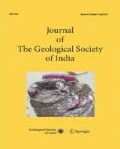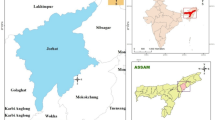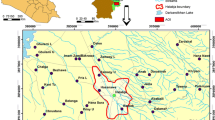Abstract
The sustainable development and management of groundwater resource needs quantitative assessment, based on scientific principle and recent techniques. In the present study, groundwater potential zone is being determined using remote sensing, Geographical Information System (GIS) and Multi-Criteria Decision Analysis (MCDA) techniques using various thematic layers viz. geomorphology, geology, drainage density, slope, rainfall, soil texture, groundwater depth, soil depth, lineament and land use/ land cover. The Analytic Hierarchy Approach (AHP) is used to determine the weights of various themes for identifying the groundwater potential zone based on weights assignment and normalization with respect to the relative contribution of the different themes to groundwater occurrence. Finally, obtained groundwater potential zones were classified into five categories, viz. low, medium, medium-high, high and very high potential zone. The result depicts the groundwater potential zone in the study area and found to be helpful in better development and management planning of groundwater resource.
Similar content being viewed by others
References
Agarwal, E., Agarwal R., Garg, R.D. and Garg, P.K. (2013) Delineation of groundwater potential zone: An AHP/ANP approach. Jour. Earth Syst. Sci., v.122(3), pp.887–898.
Aher, P. D., Adinarayana, J. and Gorantiwar, S.D. (2013) Prioritization of watersheds using multi-criteria evaluation through fuzzy analytical hierarchy process. Agriculture Engineering International, CIGR Jour., v.15(1), pp.11–18.
Bhattacharya, A.K. (2010) Artificial Ground Water Recharge with a Special Reference to India. IJRRAS, v.4(2), pp.214–221.
Bhunia, G. S., Samanta, S., Pal, B., Memorial, R. and Agamkuan, S. (2012) Deciphering prospective ground water zones of Morobe province, Papua New Guinea. Internat. Jour. Engg. Application, v.2(3), pp.752–766.
Chen, Y, Khan, S. and Paydar, Z. (2010) To retire or expand. A fuzzy GIS-based spatial multi-criteria evaluation framework for irrigated agriculture. Irrigation and drainage, v.59 (2), pp.17–188.
Chowdhury, A., Jha, M.K. and Chowdary, V.M. (2010) Delination of groundwater recharge zones and identification of artificial recharge sites in West Medinipur District, West Bengal using RS,GIS and MCDM techniques. Environmental Earth Science v.59(6),pp.1209–1222.doi: 10.1007/s12665-009-0110-9.
Chow, T.F. and Sadler, R. (2010) The consensus of local stakeholders and outside experts in suitability modeling for future camp development. Landscape and Urban Planning, v.94, pp. 9–19.
Cgwb (2009) Groundwater brochure of Durg District, Chhattisgarh. Ministry of water resources, Central Ground Water Board, North Central Region, Govt. of India, Bhopal, Madhya Pradesh. pp.5–9.
Dagdeviren, M. and Ihsan, Y. (2007) Personnel selection using analytic network process; Istanbul Ticaret Universitesi Fen Bilimleri Dergisi Yil, v. 6(11), pp.99–118.
Dalalah, D., Faris, A. and Mohammed, H. (2010) Application of the Analytic Hierarchy Process (AHP) in Multi-Criteria Analysis of the Selection of Cranes, Jordan Jour. Mech. Indust. Engg. (JJMIE), v.4(5), pp.567–78.
Dhakate, R., Rao, V.V.S.G., Raju, B.A., Mahesh, J., Rao, S.T.M. and Sankaran, S. (2012) Integrated Approach for Identifying Suitable Sites for Rainwater Harvesting Structures for Groundwater Augmentation in Basaltic Terrain. Water Resources Management, v.27(5), pp.1279–1299. doi:10.1007/s11269-012-0238-3.
Eastman, J.R. (1996) Multi-criteria Evaluation and Geographical Informationn Systems. Longley PA, Goodchild, MF, Magurie, DJ and Rhind, DW (Eds.), v.1. John Wiley and sons, New York, pp.493–502.
Fashae, O.A., Tijani, M.N., Talabi, A.O. and Adedeji, O.I. (2013) Delineation of groundwater potential zones in the crystalline basement terrain of SW-Nigeria: an integrated GIS and remote sensing approach. Applied Water Science, v.4(1), pp.19–38. doi:10.1007/s13201-013-0127-9.
Feizizadeh, B. and Blaschke, T. (2012) Land suitability analysis for Tabriz County, Iran: a multi-criteria evaluation approach using GIS. Journal of Environmental Planning and Management, pp.1–23. DOI:10.1080/09640568.2011.646964.
Ghayoumian, J., Mohseni, S. M., Feiznia, S., Nouri, B. and Malekian, A. (2007) Application of GIS techniques to determine areas most suitable for artificial groundwater recharge in a coastal aquifer in southern Iran. Jour. Asian Earth Sci., v.30, pp.364–374.
Hamilton, J. L. (2009) Planning and investigations for groundwater recharge using wetland-treated sewage effluent. Amer. Soc. Agri. Engineers, v.942074, pp.20.
Hoffmann, J. and Sander, P. (2006) Remote sensing and GIS in hydrogeology. Hydrogeology Jour., v.15(1), pp.1–3. doi:10.1007/s10040-006-0140-2.
Horton, R.E (1932) Drainage Basin Characteristics”, Transactions, American Geophysical Union, v.13, pp.35–61.
Horton, R.E (1945) Erosional Development of Streams and their Drainage Basins”, Bull. Geol. Soc. Amer., v.56, pp.275–370.
Jawad, T.Al-Bakri and Yahya, Y.Al-Jahmany (2013) Application of GIS and Remote Sensing to Groundwater Exploration in Al-Wala Basin in Jordan. Jour.Water Resource and Protection, v.5(10), pp.962–971. doi: 10.4236/jwarp.2013.510099.
Jenifa, L.C., Saravanan, S. and Palanichamy, K. (2010) A Semi Distributed Water Balance Model for Amravati River Basin using Remote Sensing and GIS. Internat. Jour. Geometrics and Geosci., v.1(2), pp.252–263.
Jha, M.K., Chowdhury, A., Chowdary, V.M. and Peiffer, S. (2007) Groundwater management and development by integrated remote sensing and geographic information systems: prospects and constraints. Water Resour. Manage., v.21(2), pp.427–467.
Kumar, T. and Jhariya, D.C. (2015) Land quality index assessment for agricultural purpose using multi-criteria decision analysis (MCDA), Geocarto International, v.21(2), pp.1–20, DOI: 10.1080/10106049.2014.997304.
Kumar, T., Gautam, A.K. and Kumar, T. (2014) Appraising the accuracy of GIS-based Multi-criteria decision making technique for delineation of Groundwater potential zones. Water Resources Management, v.28(13), pp. 4449–4466. doi:10.1007/s11269-014-0663-6.
Malczewski, J. (2004) GIS-based land-use suitability analysis: a critical overview. Progress in Planning, v.62(1), pp. 3–65.
Meshram, S. Kumud., Tripathi, M.P. and Mukharjee, A.P. (2010) Effect of Artificial Recharge Structures on Ground Water Availability in Semi-critical Area in Chhattisgarh, pp.4–23.
Nrsc (2010) Hyderabad,Remote Sensing Applications. National Remote Sensing Centre Indian Space Research Organisation Dept. of Space, Govt. of India, Balanagar, Hyderabad.
Nrsa (1995) Integrated Mission for Sustainable Development (IMSD) Technical guidelines, NRSA Hyderabad.
Pandian, M., Gayathri, D., Kanmani, G.K. and Reba, M.R. (2013) Remote sensing & GIS based approach for identification of artificial recharge zone–a case study of Palladam and Tiruppur block in Tamil Nadu, India. Internat. Jour. Remote Sensing & Geoscience (IJRSG), v.2(5), pp.26–32.
Pareta, K. and Pareta, U. (2011) Quantitative Morphometric Analysis of a Watershed of Yamuna Basin, India using ASTER (DEM). Data and GIS, v.2(1), pp.248–269.
Patel, P. and Desai, M.D. (2010) Artificial ground water recharge field study: site characterization and test results. Internat. Jour. Adv. Engg. Tech., v.I(II), pp.150–164.
Rao, S.N. (2006) Groundwater potential index in a crystalline terrain using remote sensing data. Environmental Geology, v.50(7), pp.1067–1076. doi:10.1007/s00254-006-0280-7
Saaty, T.L. (1980) TheAnalytic Hierarchy Process; McGraw-Hill, New York, NY.
Saaty, T.L. (1996) Decision making with dependence and feedback, The Analytic Network Process; RWS Publications, Pittsburgh.
Saaty, T. L. (1999) Fundamentals of the analytic network process; International Symposium of the Analytic Hierarchy Process (ISAHP), Kobe, Japan.
Saaty, T. L. (2004) Fundamentals of the analytic network process–multiple networks with benefits, costs, opportunities and risks. Jour. Systems Science and Systems Engg., v.13(3), pp.348–379.
Selvam, S., Magesh, N.S., Sivasubramanian, P., Soundranayagam, J.P., Manimaran, G. and Seshunarayana T. (2014) Deciphering of Groundwater Potential Zones in Tuticorin, Tamil Nadu, using Remote Sensing and GIS Techniques. Jour. Geol. Soc. India, v.84, pp.597–608.
Sharma, M.P. and Kujur, A. (2012) Application of Remote Sensing and GIS for groundwater recharge zone in and around Goal Block, Ramgargh district, Jharkhand, India. Internat. Jour. Sci. Res. Publ., v.2( 2), pp.1–6.
Singh, P.K., Bhardwaj, O.A. and Kumar, A. (2011) Site selection for ground water recharge using treated municipal wastewaters -a case study of Varanasi (India). Recent Adv. Civil Engg., pp.122–130.
Suryawanshi, S.L. (2011) Application of RS and GIS Technologies Land Resources Characterization and Watersheds Management a Case Study of Malegaon Watersheds. Jour. Soil Water Conserv., v.10(2), pp.98–103.
Strahler, A.N. (1952) Hypsometric Analysis of Erosional Topography. Bull. Geol. Soc. Amer., v.63, pp.1117–1142.
Strahler, A.N. (1957) Quantitative analysis of watershed geomorphology. Trans. Amer. Geophys. Union, v.38, pp.913–920.
Taheri, A. and Zare, M. (2011) Groundwater artificial recharge assessment in Kangavar Basin, a semi-arid region in the western part. African Jour. Agri. Res., v.6(17), pp.4370–4384.
Yu, J., Chean, Y. and Wu, J. P. (2009) Cellular automata and GIS based land use suitability simulation for irrigated agriculture. 18th world IMACS/MODSIM Congress July, Cairns, Australia, pp.13–17.
Voroney, R. P. (2006) The Soil Habitat. In: Paul, Eldor A. (Ed.), Soil Microbiology, Ecology and Biochemistry. ISBN 0-12-546807-5.
Author information
Authors and Affiliations
Corresponding author
Rights and permissions
About this article
Cite this article
Jhariya, D.C., Kumar, T., Gobinath, M. et al. Assessment of groundwater potential zone using remote sensing, GIS and multi criteria decision analysis techniques. J Geol Soc India 88, 481–492 (2016). https://doi.org/10.1007/s12594-016-0511-9
Received:
Accepted:
Published:
Issue Date:
DOI: https://doi.org/10.1007/s12594-016-0511-9




